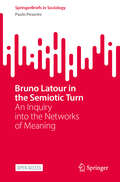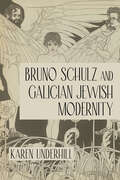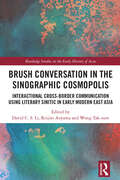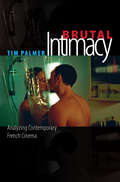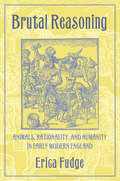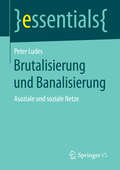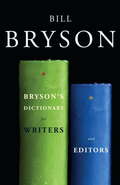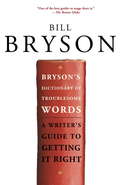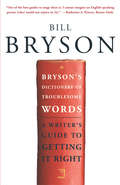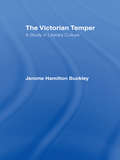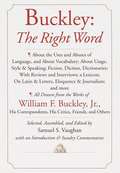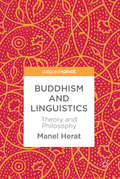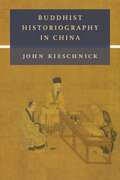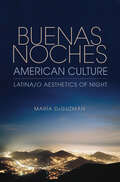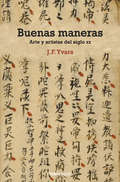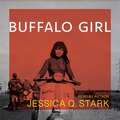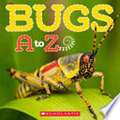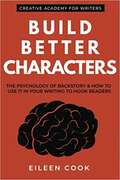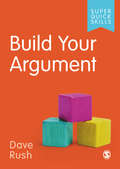- Table View
- List View
Bruno Latour in the Semiotic Turn: An Inquiry into the Networks of Meaning (SpringerBriefs in Sociology)
by Paolo PeveriniThis open access book highlights the link between Bruno Latour's works and the semiotic perspective on social phenomena analysis. It identifies and relaunches a dialogue that was as heated as it was fruitful, but still little recognized within the social sciences. It asks why the theory of signification has so far been only sporadically acknowledged in literature derived from Latour's work. Starting from these premises, the book explores two interrelated dimensions, the initial one of a "semiotics for Latour", which looks at concepts from semiotics in Latour's study of social phenomena, and extensively for the first time, a symmetrical one of a "Latour for semiotics," accounting for the impact of Latourian inquiry on contemporary semiotic research. The book offers a novel perspective on Bruno Latour's work by addressing a wide readership, including those interested in Latour’s approach, actor-network theory, semiotics, and the social sciences. The English translation of this book from the Italian original manuscript was done with the help of artificial intelligence, then revised technically and linguistically by the author in collaboration with a professional translator.
Bruno Schulz and Galician Jewish Modernity (Jews in Eastern Europe)
by Karen UnderhillIn the 1930s, through the prose of Bruno Schulz (1892–1942), the Polish language became the linguistic raw material for a profound exploration of the modern Jewish experience. Rather than turning away from the language like many of his Galician Jewish colleagues who would choose to write in Yiddish, Schulz used the Polish language to explore his own and his generation's relationship to East European Jewish exegetical tradition, and to deepen his reflection on golus or exile as a condition not only of the individual and of the Jewish community, but of language itself, and of matter. Drawing on new archival discoveries, this study explores Schulz's diasporic Jewish modernism as an example of the creative and also transient poetic forms that emerged on formerly Habsburg territory, at the historical juncture between empire and nation-state.
Brush Conversation in the Sinographic Cosmopolis: Interactional Cross-border Communication using Literary Sinitic in Early Modern East Asia (Routledge Studies in the Early History of Asia)
by David C. S. Li Reijiro Aoyama Wong Tak-SumFor hundreds of years until the 1900s, in today’s China, Japan, North and South Korea, and Vietnam, literati of Classical Chinese or Literary Sinitic (wényán 文言) could communicate in writing interactively, despite not speaking each other’s languages. This book outlines the historical background of, and the material conditions that led to,widespread literacy development in premodern and early modern East Asia, where reading and writing for formal purposes was conducted in Literary Sinitic. To exemplify how ‘silent conversation’ or ‘brush-assisted conversation’ is possible through writing-mediated brushed interaction, synchronously face-to-face, this book presents contextualized examples from recurrent contexts involving (i) boat drifters; (ii) traveling literati; and (iii) diplo- matic envoys. Where profound knowledge of classical canons and literary works in Sinitic was a shared attribute of the brush-talkers concerned, their brush-talk would characteristically be intertwined with poetic improvisation. Being the first monograph in English to address this fascinating lingua-cultural practice and cross-border communication phenomenon, which was possibly sui generis in Sinographic East Asia, it will be of interest to students of not only East Asian languages and linguistics, history, international relations, and diplomacy, but also (historical) pragmatics, sociolinguistics, sociology of language, scripts and writing systems, and cultural and linguistic anthropology.
Brutal Intimacy: Analyzing Contemporary French Cinema (Wesleyan Film)
by Tim PalmerBrutal Intimacy is the first book to explore the fascinating films of contemporary France, ranging from mainstream genre spectaculars to arthouse experiments, and from wildly popular hits to films that deliberately alienate the viewer. Twenty-first-century France is a major source of international cinema--diverse and dynamic, embattled yet prosperous--a national cinema offering something for everyone. Tim Palmer investigates France's growing population of women filmmakers, its buoyant vanguard of first-time filmmakers, the rise of the controversial cinema du corps, and France's cinema icons: auteurs like Olivier Assayas, Claire Denis, Bruno Dumont, Gaspar Noe, and stars such as Vincent Cassel and Jean Dujardin. Analyzing dozens of breakthrough films, Brutal Intimacy situates infamous titles alongside many yet to be studied in the English language. Drawing on interviews and the testimony of leading film artists, Brutal Intimacy promises to be an influential treatment of French cinema today, its evolving rivalry with Hollywood, and its ambitious pursuits of audiences in Europe, North America, and around the world.
Brutal Reasoning: Animals, Rationality, and Humanity in Early Modern England
by Erica FudgeEarly modern English thinkers were fascinated by the subject of animal rationality, even before the appearance of Descartes's Discourse on the Method (1637) and its famous declaration of the automatism of animals. But as Erica Fudge relates in Brutal Reasoning, the discussions were not as straightforward—or as reflexively anthropocentric—as has been assumed. Surveying a wide range of texts-religious, philosophical, literary, even comic-Fudge explains the crucial role that reason played in conceptualizations of the human and the animal, as well as the distinctions between the two. Brutal Reasoning looks at the ways in which humans were conceptualized, at what being "human" meant, and at how humans could lose their humanity. It also takes up the questions of what made an animal an animal, why animals were studied in the early modern period, and at how people understood, and misunderstood, what they saw when they did look.From the influence of classical thinking on the human-animal divide and debates surrounding the rationality of women, children, and Native Americans to the frequent references in popular and pedagogical texts to Morocco the Intelligent Horse, Fudge gives a new and vital context to the human perception of animals in this period. At the same time, she challenges overly simplistic notions about early modern attitudes to animals and about the impact of those attitudes on modern culture.
Brutalisierung und Banalisierung: Asoziale Und Soziale Netze (Essentials)
by Peter LudesPeter Ludes entlarvt Brutalisierung und Banalisierung in kollektiven Mythen – für eine Emanzipation der Sinne im Zeitalter ihrer technischen Vereinnahmung. Denn Informations- und Kommunikationstechnologien dienen nicht nur der Ausweitung von Kommunikation, sondern auch als Kampfmittel. Insoweit sie aufgrund ihrer leicht zugänglichen, scheinbar kostenlosen Verbreitung als relativ natürliche Weltbedingungen erlebt werden, konstituieren sie neue Mythen der unbegrenzten, freien Kommunikation. Welche Perspektiven und Praktiken werden aber wie vorgegeben und formatiert? Wie wird das komplexe und widersprüchliche Zusammenspiel und Gegeneinander von fiktiven Behauptungen und verdrängten ‚Tat-Sachen‘ zu einem neuen Problem? Es geht zum Schluss um unterschiedlich vernetzte lokale Kontakt- und globale virtuelle Machtzonen, die hier symbolisch aufgehoben werden mit Abrechnungen für die acht reichsten Männer der Erde.Der Autor Dr. Peter Ludes, PhD (USA), habilitierter Soziologe, apl. Professor für Kultur- und Medienwissenschaft in Siegen. Professor für Massenkommunikation an der Jacobs University Bremen 2002-2017, Gastprofessor an der Universität Köln.
Bryson's Dictionary for Writers and Editors
by Bill BrysonFrom one of America's most beloved and bestselling authors, a wonderfully useful and readable guide to the problems of the English language most commonly encountered by editors and writers.What is the difference between &“immanent&” and &“imminent&”? What is the singular form of graffiti? What is the difference between &“acute&” and &“chronic&”? What is the former name of &“Moldova&”? What is the difference between a cardinal number and an ordinal number? One of the English language's most skilled writers answers these and many other questions and guides us all toward precise, mistake-free usage. Covering spelling, capitalization, plurals, hyphens, abbreviations, and foreign names and phrases, Bryson's Dictionary for Writers and Editors will be an indispensable companion for all who care enough about our language not to maul, misuse, or contort it.This dictionary is an essential guide to the wonderfully disordered thing that is the English language. As Bill Bryson notes, it will provide you with &“the answers to all those points of written usage that you kind of know or ought to know but can&’t quite remember.&”BONUS MATERIAL: This ebook edition includes an excerpt from Bill Bryson's One Summer.
Bryson's Dictionary of Troublesome Words
by William BrysonOne of the English language's most skilled and beloved writers guides us all towards precise, mistake-free usage.In the middle 1980s Bill Bryson was a copy editor for the London Times with the brash idea that he could fill a hole in the British book market for a concise, accessible, handy guide to proper usage. A complete unknown, he nonetheless sold Penguin Books on the idea, and the result was The Penguin Dictionary of Troublesome Words, which sold decently enough on both sides of the Atlantic.Now, fifteen years later, Bill Bryson has become, well, Bill Bryson -- and his terrifically useful little book has been revised, updated and Americanized to become Bryson's Dictionary of Troublesome Words. Precise, prescriptive, sometimes (like its author) amusingly prickly, this book belongs on the desk of every person who cares enough about our language not to maul or misuse or distort it. Move over, Strunk and White.
Bryson's Dictionary of Troublesome Words: A Writer's Guide to Getting It Right
by Bill BrysonOne of the English language's most skilled and beloved writers guides us all toward precise, mistake-free usage.As usual Bill Bryson says it best: "English is a dazzlingly idiosyncratic tongue, full of quirks and irregularities that often seem willfully at odds with logic and common sense. This is a language where 'cleave' can mean to cut in half or to hold two halves together; where the simple word 'set' has 126 different meanings as a verb, 58 as a noun, and 10 as a participial adjective; where if you can run fast you are moving swiftly, but if you are stuck fast you are not moving at all; [and] where 'colonel,' 'freight,' 'once,' and 'ache' are strikingly at odds with their spellings." As a copy editor for the London Times in the early 1980s, Bill Bryson felt keenly the lack of an easy-to-consult, authoritative guide to avoiding the traps and snares in English, and so he brashly suggested to a publisher that he should write one. Surprisingly, the proposition was accepted, and for "a sum of money carefully gauged not to cause embarrassment or feelings of overworth," he proceeded to write that book-his first, inaugurating his stellar career.Now, a decade and a half later, revised, updated, and thoroughly (but not overly) Americanized, it has become Bryson's Dictionary of Troublesome Words, more than ever an essential guide to the wonderfully disordered thing that is the English language. With some one thousand entries, from "a, an" to "zoom," that feature real-world examples of questionable usage from an international array of publications, and with a helpful glossary and guide to pronunciation, this precise, prescriptive, and-because it is written by Bill Bryson-often witty book belongs on the desk of every person who cares enough about the language not to maul or misuse or distort it.From the Hardcover edition.
Buckle Down Writing Level 7
by The Editors at the Buckle Down PublishingBuckle Down Writing is designed to help you practice and polish your writing skills. This book will review all four stages of the writing process: pre-writing,drafting,revising and editing.
Buckley: A Study in Literary Culture
by Jerome Hamilton Buck;eyFirst Published in 1966. Routledge is an imprint of Taylor & Francis, an informa company.
Buckley: The Right Word
by Samuel S. Vaughan William F. Buckley Jr.The book his readers have asked for -- on the uses and abuses of language, vocabulary, diction and dictionaries, journals and journalists, style, eloquence, interviews and reviews -- "Buckley: The Right Word" includes interviews with Charlie Rose and The Paris Review, verbal encounters with Borges, Le Carre, Galbraith, Schlesinger, Playboy, Cosmopolitan, The New York Times, essays on formality and style -- even a Buckley lexicon.
Buddhism and Linguistics: Theory and Philosophy
by Manel HeratThis edited collection brings linguistics into contact with a millennia of works by Buddhist scholars. Examining the Buddhist contemplative tradition and its extensive writings from an interdisciplinary perspective, the authors bridge the gap between such customs and human language. To do so, they provide chapters on linguistics, history, religious studies, philosophy and semiotics. Uniting scholars from three different continents and from many disciplines and institutions, this innovative and unique book is sure to appeal to anyone interested in Buddhist traditions and linguistics.
Buddhist Historiography in China (The Sheng Yen Series in Chinese Buddhist Studies)
by John KieschnickSince the early days of Buddhism in China, monastics and laity alike have expressed a profound concern with the past. In voluminous historical works, they attempted to determine as precisely as possible the dates of events in the Buddha’s life, seeking to iron out discrepancies in varying accounts and pinpoint when he delivered which sermons. Buddhist writers chronicled the history of the Dharma in China as well, compiling biographies of eminent monks and nuns and detailing the rise and decline in the religion’s fortunes under various rulers. They searched for evidence of karma in the historical record and drew on prophecy to explain the past.John Kieschnick provides an innovative, expansive account of how Chinese Buddhists have sought to understand their history through a Buddhist lens. Exploring a series of themes in mainstream Buddhist historiographical works from the fifth to the twentieth century, he looks not so much for what they reveal about the people and events they describe as for what they tell us about their compilers’ understanding of history. Kieschnick examines how Buddhist doctrines influenced the search for the underlying principles driving history, the significance of genealogy in Buddhist writing, and the transformation of Buddhist historiography in the twentieth century. This book casts new light on the intellectual history of Chinese Buddhism and on Buddhists’ understanding of the past.
Budding Reader Book Set 1: Cat and Rat (Budding Reader #1)
by Cecilia Minden Bill Madrid Doug Oglesby Melinda Thompson Melissa FerrellReading is a neurologically complex skill. So, it isn't surprising that many children find learning to read difficult. Make learning to read more fun with award-winning Budding Reader eBooks, arguably the easiest learn-to-read book series on the market. These research-based eBooks were developed in consultation with Cecilia Minden, Ph.D., the former Director of Language and Literacy at the Harvard Graduate School of Education. They were illustrated by artist, Doug Oglesby, winner of one Emmy, five Emmy nominations, and three international awards from the Broadcast Designers Association. Budding Reader eBooks use an innovative format to ease children into reading. Using research-based best practices identified by the National Reading Panel, each of the five Budding Reader eBook sets (one for each short vowel sound) tells an original story over the course of ten books. Previewing a book dramatically improves reading comprehension, so Book 1 in each set is a wordless picture book which introduces the story through colorful illustrations. Repetition aids brain development, so the story is retold in Books 2-10 with an ever-expanding vocabulary. By repeating words and gradually adding new ones, Budding Reader eBooks help new readers (even reluctant ones) experience success from the very start.In total, the Budding Reader eBook series introduces more than 60 simple words including dozens of common sight words. Learning is reinforced with free companion writing worksheets (available at buddingreader.com) which provide a multisensory experience and enable children to practice both reading and writing. A free parent guide with tips for working with new readers is also available on the website. The first set in the series, Cat and Rat, introduces the short "a" vowel sound and is designed to be a child's very first reader. With only eleven words (and, at, can, cat, look, rat, see, stop, that, the, you) introduced over the course of ten books, Cat and Rat aims to provide even the most reluctant reader with a positive first introduction to reading. Series: *Set 1: Cat and Rat (Short a; 11 words) *Set 2: Wit and Kit (Short i; 17 words) *Set 3: Bugs (Short u; 18 words) *Set 4: Hop! (Short o; 18 words) *Set 5: Hens (Short e; 22 words) For every eBook set sold, Budding Reader donates one to a child in need. One for You. One for the World. A Better World with Every Purchase. Gold Mom's Choice Award Winner: The Mom's Choice Awards has named Cat and Rat among the very best in family-friendly media, products and services. This content is optimized for tablets.
Budding Reader Book Set 2: Wit And Kit (Budding Reader #2)
by Cecilia Minden Bill Madrid Doug Oglesby Melinda Thompson Melissa FerrellReading is a neurologically complex skill. So, it isn’t surprising that many children find learning to read difficult. Make learning to read more fun with award-winning Budding Reader eBooks, arguably the easiest learn-to-read book series on the market. These research-based eBooks were developed in consultation with Cecilia Minden, Ph.D., the former Director of Language and Literacy at the Harvard Graduate School of Education. They were illustrated by artist, Doug Oglesby, winner of one Emmy, five Emmy nominations, and three international awards from the Broadcast Designers Association. Budding Reader eBooks use an innovative format to ease children into reading. Using research-based best practices identified by the National Reading Panel, each of the five Budding Reader eBook sets (one for each short vowel sound) tells an original story over the course of ten books. Previewing a book dramatically improves reading comprehension, so Book 1 in each set is a wordless picture book which introduces the story through colorful illustrations. Repetition aids brain development, so the story is retold in Books 2-10 with an ever-expanding vocabulary. By repeating words and gradually adding new ones, Budding Reader eBooks help new readers (even reluctant ones) experience success from the very start.In total, the Budding Reader eBook series introduces more than 60 simple words including dozens of common sight words. Learning is reinforced with free companion writing worksheets (available at buddingreader.com) which provide a multisensory experience and enable children to practice both reading and writing. A free parent guide with tips for working with new readers is also available on the website. The second set in the series, Wit and Kit, introduces the short “i” vowel sound and 13 new words (bit, by, did, good, he, hit, I, it, Kit, no, quit, she, Wit). Four simple words previously introduced in the series (and, see, that, you) are reviewed.Series: •Set 1: Cat and Rat (Short a; 11 words) •Set 2: Wit and Kit (Short i; 17 words) •Set 3: Bugs (Short u; 18 words) •Set 4: Hop! (Short o; 18 words) •Set 5: Hens (Short e; 22 words) For every eBook set sold, Budding Reader donates one to a child in need. One for You. One for the World. A Better World with Every Purchase. Gold Mom’s Choice Award Winner: The Mom’s Choice Awards has named Wit and Kit among the very best in family-friendly media, products and services. This content is optimized for tablets.
Budding Reader Book Set 3: Bugs (Budding Reader #3)
by Cecilia Minden Bill Madrid Doug Oglesby Melinda Thompson Melissa FerrellReading is a neurologically complex skill. So, it isn’t surprising that many children find learning to read difficult. Make learning to read more fun with award-winning Budding Reader eBooks, arguably the easiest learn-to-read book series on the market. These research-based eBooks were developed in consultation with Cecilia Minden, Ph.D., the former Director of Language and Literacy at the Harvard Graduate School of Education. They were illustrated by artist, Doug Oglesby, winner of one Emmy, five Emmy nominations, and three international awards from the Broadcast Designers Association. Budding Reader eBooks use an innovative format to ease children into reading. Using research-based best practices identified by the National Reading Panel, each of the five Budding Reader eBook sets (one for each short vowel sound) tells an original story over the course of ten books. Previewing a book dramatically improves reading comprehension, so Book 1 in each set is a wordless picture book which introduces the story through colorful illustrations. Repetition aids brain development, so the story is retold in Books 2-10 with an ever-expanding vocabulary. By repeating words and gradually adding new ones, Budding Reader eBooks help new readers (even reluctant ones) experience success from the very start.In total, the Budding Reader eBook series introduces more than 60 simple words including dozens of common sight words. Learning is reinforced with free companion writing worksheets (available at buddingreader.com) which provide a multisensory experience and enable children to practice both reading and writing. A free parent guide with tips for working with new readers is also available on the website. The third Budding Reader eBook set, Bugs, features the short “u” vowel sound. It introduces 14 new words (big, bug, bugs, down, give, go, her, hug, hugs, on, out, past, them, to) and reviews four simple words previously introduced in the series (and, by, see, the).Series: •Set 1: Cat and Rat (Short a; 11 words) •Set 2: Wit and Kit (Short i; 17 words) •Set 3: Bugs (Short u; 18 words) •Set 4: Hop! (Short o; 18 words) •Set 5: Hens (Short e; 22 words) For every eBook set sold, Budding Reader donates one to a child in need. One for You. One for the World. A Better World with Every Purchase. Gold Mom’s Choice Award Winner: The Mom’s Choice Awards has named Bugs among the very best in family-friendly media, products and services. This content is optimized for tablets.
Budding Reader Book Set 4: Hop! (Budding Reader #4)
by Cecilia Minden Bill Madrid Doug Oglesby Melinda Thompson Melissa FerrellReading is a neurologically complex skill. So, it isn’t surprising that many children find learning to read difficult. Make learning to read more fun with award-winning Budding Reader eBooks, arguably the easiest learn-to-read book series on the market. These research-based eBooks were developed in consultation with Cecilia Minden, Ph.D., the former Director of Language and Literacy at the Harvard Graduate School of Education. They were illustrated by artist, Doug Oglesby, winner of one Emmy, five Emmy nominations, and three international awards from the Broadcast Designers Association. Budding Reader eBooks use an innovative format to ease children into reading. Using research-based best practices identified by the National Reading Panel, each of the five Budding Reader eBook sets (one for each short vowel sound) tells an original story over the course of ten books. Previewing a book dramatically improves reading comprehension, so Book 1 in each set is a wordless picture book which introduces the story through colorful illustrations. Repetition aids brain development, so the story is retold in Books 2-10 with an ever-expanding vocabulary. By repeating words and gradually adding new ones, Budding Reader eBooks help new readers (even reluctant ones) experience success from the very start.In total, the Budding Reader eBook series introduces more than 60 simple words including dozens of common sight words. Learning is reinforced with free companion writing worksheets (available at buddingreader.com) which provide a multisensory experience and enable children to practice both reading and writing. A free parent guide with tips for working with new readers is also available on the website. The fourth Budding Reader eBook set, Hop!, features the short “o” vowel sound. It introduces 11 new words (Bop, do, hop, hops, looks, Mop, Pop, not, they, up, will) and reviews seven simple words previously introduced in the series (and, at, down, go, look, on, stop).Series: •Set 1: Cat and Rat (Short a; 11 words) •Set 2: Wit and Kit (Short i; 17 words) •Set 3: Bugs (Short u; 18 words) •Set 4: Hop! (Short o; 18 words) •Set 5: Hens (Short e; 22 words) For every eBook set sold, Budding Reader donates one to a child in need. One for You. One for the World. A Better World with Every Purchase. Gold Mom’s Choice Award Winner: The Mom’s Choice Awards has named Hop! among the very best in family-friendly media, products and services. This content is optimized for tablets.
Budding Reader Book Set 5: Hens (Budding Reader #5)
by Cecilia Minden Bill Madrid Doug Oglesby Melinda Thompson Melissa FerrellReading is a neurologically complex skill. So, it isn’t surprising that many children find learning to read difficult. Make learning to read more fun with award-winning Budding Reader eBooks, arguably the easiest learn-to-read book series on the market. These research-based eBooks were developed in consultation with Cecilia Minden, Ph.D., the former Director of Language and Literacy at the Harvard Graduate School of Education. They were illustrated by artist, Doug Oglesby, winner of one Emmy, five Emmy nominations, and three international awards from the Broadcast Designers Association. Budding Reader eBooks use an innovative format to ease children into reading. Using research-based best practices identified by the National Reading Panel, each of the five Budding Reader eBook sets (one for each short vowel sound) tells an original story over the course of ten books. Previewing a book dramatically improves reading comprehension, so Book 1 in each set is a wordless picture book which introduces the story through colorful illustrations. Repetition aids brain development, so the story is retold in Books 2-10 with an ever-expanding vocabulary. By repeating words and gradually adding new ones, Budding Reader eBooks help new readers (even reluctant ones) experience success from the very start.In total, the Budding Reader eBook series introduces more than 60 simple words including dozens of common sight words. Learning is reinforced with free companion writing worksheets (available at buddingreader.com) which provide a multisensory experience and enable children to practice both reading and writing. A free parent guide with tips for working with new readers is also available on the website. The fifth Budding Reader eBook set, Hens, features the short “e” vowel sound. It introduces 14 new words (are, chick, chicks, egg, eggs, Em, hen, hens, house, in, is, Jen, next, who) and reviews eight simple words previously introduced in the series (at, look, looks, see, that, the, them, to). Series: •Set 1: Cat and Rat (Short a; 11 words) •Set 2: Wit and Kit (Short i; 17 words) •Set 3: Bugs (Short u; 18 words) •Set 4: Hop! (Short o; 18 words) •Set 5: Hens (Short e; 22 words) For every eBook set sold, Budding Reader donates one to a child in need. One for You. One for the World. A Better World with Every Purchase. Gold Mom’s Choice Award Winner: The Mom’s Choice Awards has named Hens among the very best in family-friendly media, products and services. This content is optimized for tablets.
Buenas Noches, American Culture: Latina/o Aesthetics of Night
by María DeGuzmánOften treated like night itself—both visible and invisible, feared and romanticized—Latina/os make up the largest minority group in the US. In her newest work, María DeGuzmán explores representations of night in art and literature from the Caribbean, Colombia, Central and South America, and the US, calling into question night's effect on the formation of identity for Latina/os in and outside of the US. She takes as her subject novels, short stories, poetry, essays, non-fiction, photo-fictions, photography, and film, and examines these texts through the lenses of nationhood, sexuality, human rights, exoticism, among others.
Buenas maneras: Arte y artistas del siglo XX
by José Francisco YvarsUna colección de ensayos de J.F. Yvars sobre arte del siglo XX. Con el título de Buenas maneras. Arte y artistas del siglo XX, se reúnen algunos ensayos que J.F. Yvars ha publicado de manera dispersa en catálogos, periódicos y revistas especializadas a lo largo de los últimos cinco años. Unos textos precisos y acerados que aúnan el rigor científico con una clara vocación divulgativa. Un «puñado de indagaciones sobre el arte de nuestro tiempo», en palabras del autor, que apuntan las condiciones del diálogo artístico moderno -de la obra de Torres-García, Pablo Picasso, Giorgio Morandi a Andy Warhol, entre otros- en el excitante momento cultural en que vivimos.
Buffalo Girl (American Poets Continuum Series #199)
by Jessica Q. StarkIn these hybrid poems, Jessica Q. Stark explores her mother’s fraught immigration to the United States from Vietnam at the end of war through the lens of the Little Red Riding Hood fairy tale.Told through personal, national, and cultural histories, Buffalo Girl is a feminist indictment of the violence used to define and control women's bodies. Interspersed throughout this hybrid work are a series of collaged photographs, featuring Stark’s mother’s black-and-white photography from Vietnam beautifully and hauntingly layered over various natural landscapes — lush tropical plants, dense forests, pockets of wildflowers. Several illustrations from old Red Riding Hood children’s books can also be found embedded into these pieces. Juxtaposing the moral implications of Little Red Riding Hood with her mother's photography, Stark creates an image-text conversation that attends to the wolves lurking in the forests of our everyday lives. Opening the whispered frames around sexuality and sex work, immersed in the unflattering symptoms of survival, Buffalo Girl burgeons with matrilineal love and corporeal rage while censuring the white gaze and the violence enacted through the English language. Here is an inversion of diasporic victimhood. Here is an unwavering attention to the burdens suffered by the women of this world. Here is a reimagination, a reclamation, a way out of the woods.
Bugs A To Z
by Caroline LawtonAn essential A to Z bug book for young readers. The perfect book for all kids who are fascinated with bugs. Simple text from A to Z provides buggy facts and figures. Larger than life full-color photographs of creepy crawlies include locusts, caterpillars, beetles, flies, grasshoppers, ants, praying mantis, and more!
Build Better Characters
by Eileen CookCompelling characters are what keeps readers turning pages and buying books — from fantasies to mysteries to the great literary novel. But how to do you create characters that feel three dimensional and real on the page? <p><p> Counsellor and author Eileen Cook shares common psychological techniques to help you build your characters and take your story to the next level. <p><p> Covering understanding your character's backstory and how it impacts their choices in your book by doing a structured counselling interview, personality structure (Myers Briggs and Emotional Intelligence) and how that may lead to conflict, and understand dissecting the Stages of Change to see how your character moves through them . <p><p> Filled with practical tips, examples and prompts this is a craft book you will return to over and over. <p><p> This is the second book in the Creative Academy Guides for Writers series. Be sure to check out the rest of the guides for writers in this series.
Build Your Argument (Super Quick Skills)
by Dave RushTrying to make sense of making an argument? This straightforward book breaks down how to build a convincing argument for any type of assessment. Find out what an academic argument is – and what it is not Develop a toolkit for structuring an argument effectively Learn how to use evidence and counterarguments to back up your position. Super Quick Skills provides the essential building blocks you need to succeed at university - fast. Packed with practical, positive advice on core academic and life skills, you’ll discover focused tips and strategies to use straight away. Whether it’s writing great essays, understanding referencing or managing your wellbeing, find out how to build good habits and progress your skills throughout your studies. Learn core skills quickly Apply them right away and see results Succeed in your studies and in life Super Quick Skills gives you the foundations you need to confidently navigate the ups and downs of university life.
